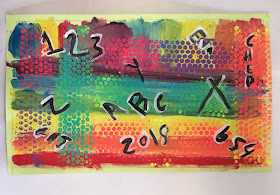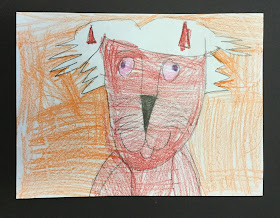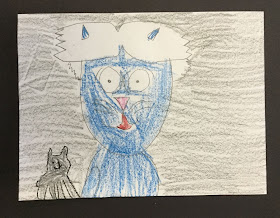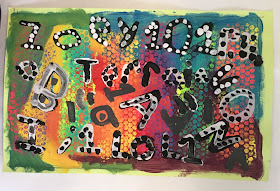This was a delightful read for my Kinders who speculated that the Warhol's must have had at least 1000 Sam's living in their home. They were hysterical with the idea that Hester and Sam might have slept in Andy's wig drawer with all their offspring's and they were sure the wigs must have been an extremely comfortable place to sleep.
So began a Kindergarten lesson on Pop Art, no it's not like popping a balloon, and an introduction to Andy Warhol.
Students followed a directed draw to create this sweet little composition featuring a cat in a wig and sometimes with a smaller Sam (kitten) in the background. Students were encouraged to practice skill and creative embellishment in their work. Choices in color for the cats were left up to the student's discretion. Here are a few of the finished projects, definitely worth sharing!!!
Pages
▼
Saturday, March 17, 2018
Jasper Johns interpretation by 5th grade
 |
| "Alphabet" by Jasper Johns was the piece used for inspiration. |
 At a recent professional day experience, our group shared ideas for printmaking. One of my colleagues shared a variation of this project. She had planned the project as a color mixing experience for Kinders. With a twist, I introduced it to 5th grade students who totally enjoyed the color review and the opportunity to add individualized touches to their work.
At a recent professional day experience, our group shared ideas for printmaking. One of my colleagues shared a variation of this project. She had planned the project as a color mixing experience for Kinders. With a twist, I introduced it to 5th grade students who totally enjoyed the color review and the opportunity to add individualized touches to their work.  Week one student were given tempera colors in the primaries and instructed to paint all the colors of the color wheel. They were further told they could not mix colors on their pallets but instead had to mix right on the painting surface. There were not specific instructions as to how the finished work should appear, only that it should be non-representational.
Week one student were given tempera colors in the primaries and instructed to paint all the colors of the color wheel. They were further told they could not mix colors on their pallets but instead had to mix right on the painting surface. There were not specific instructions as to how the finished work should appear, only that it should be non-representational.
 Week two students used tempera in the fluorescent primary colors to mix secondary colors and print using bubble wrap. They did the mixing right on the bubble wrap. Very messy, but they all seems to really enjoy the bubble mixing process. (Paint one primary on each end of a strip of bubble, fold and rub the two ends together to mix.) At this step, they reviewed show colors "work" off one another and were reminded that complementary colors seem to "pop" when used together. Personal choices were made as to where to place the different color prints. As they completed this step, drawing paper was used along with any left over paint to practice painting letters and numbers using a flat paint brush.
Week two students used tempera in the fluorescent primary colors to mix secondary colors and print using bubble wrap. They did the mixing right on the bubble wrap. Very messy, but they all seems to really enjoy the bubble mixing process. (Paint one primary on each end of a strip of bubble, fold and rub the two ends together to mix.) At this step, they reviewed show colors "work" off one another and were reminded that complementary colors seem to "pop" when used together. Personal choices were made as to where to place the different color prints. As they completed this step, drawing paper was used along with any left over paint to practice painting letters and numbers using a flat paint brush.
Week three began with additional practice with the paint brush if students felt it would be beneficial. They moved on to adding letters and numbers to their paintings. I was delighted with the variety and the enthusiasm as students moved through this project.




